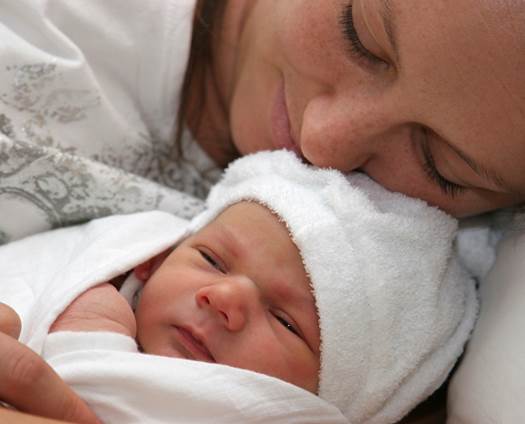It costs the same as IVF but, rather
than giving you just one shot at conceiving, a radical new treatment claims to
rewind your fertility. We investigate the controversial technique coming this
year.
Ten years ago, egg freezing seemed like a
sci-fi fantasy come true. Now, a new fertility treatment makes it look
positively passé. Why freeze a few eggs when having sections of your ovarian
tissue removed and put on ice could give you up to 60,000 eggs long after your
body would have stopped producing them naturally?

Almost
half of young women are delaying motherhood
because they don't want to give up their freedom, a new survey has revealed.
Until now, ovarian tissue freezing (OTF)
has only been conducted in a handful of countries, including Denmark and the
US, and has been restricted to cancer patients receiving chemotherapy. But such
is the buzz surrounding in that, this year, fertility consultant Dr Gedis
Grudzinskas (grudzinskas.co.uk) is set to open a London clinic dedicated to the
treatment. ‘Fertility preservation is an incredibly exciting field right now,’
he says. And though OTF is a relatively new procedure, 28 babies have been born
as a result of it. Some expert believe it has the potential to become more
popular and successful than egg freezing and even IVF - in fact, it costs about
$24,000, not far off the cost of the average three cycles of IVF most couples
need to conceive.
It involves removing tissue from one ovary
under general anaesthetic, and then freezing it thus stopping the clock to
perverse the health of your egg stores, which would otherwise deteriorate over
time. The frozen tissue can then be thawed out and re-implanted into the body
to take up where it left off when conception is desired. Successful pregnancies
have occurred up to seven years after freezing.
‘Freezing ovarian tissue is suitable for
cancer patients’, says Dr Geetha Venkat, founder of the Harley Street Fertility
Clinic (hsfc.org.uk). ‘Unlike egg freezing, which can take around eight weeks
of hormone therapy to harvest around 10 eggs OFT can be performed quickly, so
as not to delay cancer treatment.’ But it’s not just cancer patients who’ll
want to sign up for OTF. ‘It may also be suitable for women who have benign
ovarian disease, such as endometriosis,’ explains Dr Grudzinskas, ‘or other
issues that put them at risk of early menopause.’ But by far the fastest
growing group seeking fertility preservation, he claims, is healthy women who
want to delay motherhood. ‘We’re definitely seeing more women who have
postponed having babies for their career, he says. But Dr Gillian Lockwood,
spokesperson for the British Fertility Soceity and Medical Director at Midland
Fertility Services (midlandfertility.com) is keen to make a distinction. ‘Yes,
there are more women seeking fertility preservation for lifestyle reasons,’ she
says. ‘But it’s not simply a case of them being so busy in the boardroom they
“forgot” to have children. Most just haven’t met Mr Right or did, but he turned
out to be Mr Wrong’.

‘Freezing
ovarian tissue is suitable for cancer patients’
New science
But while there’s demand for ovarian
freezing, it’s still in its infancy. ‘This is largely an experimental
treatment,’ points out Dr Lockwood. Dr Venkat agrees: ‘It’s ideal for cancer
patients who risk losing their fertility post treatment anyway, or women who
are already sub fertile,’ she says, ‘but, for healthy women, other, less
invasive options, such as egg harvesting, might be more suitable. After all,
surgery isn’t without risk. Healthy ovarian tissue could become damaged,
compromising your fertility.’
Dr Grudzinskas dismisses the dangers. ‘If
it’s peformed by a team of top anesthesiologists, cell biologists and leading
Gynaecologists, the risks are minimal.’ He cites Denmark, the leader in the
ovarian freezing field, as a model for best practice. ‘Anyone can freeze
ovarian tissue getting it right is the real challenge.’ Indeed, none of the
babies born from ovarian tissue freezing have been delivered in the UK. ‘This
is the real measure of success,’ points out Dr Lockwood. ‘Compare that with egg
freezing, where hundreds of healthy babies have been born and I know which I’d
rather spend my money on.’
Cost, of course, is a consideration. While
egg freezing will set you back $7500, OTF costs over three times as much. But,
as Dr Grudzinskas says, conception should be able to occur naturally after the
ovarian tissue is re-implanted (ovulation starts within months, as the
follicles mature naturally) so, unlike IVF, there’d be no further costs if you
wanted more children. In fact, one Danish former cancer patient has had three
children naturally, after OTF. Plus, as with any increasingly popular therapy,
the price is likely to fall as demand rises, which it looks set to do now the
academics appear to have given it the green light. A recent review of OTF in
the Journal of Molecular Human Reproduction concluded that the results
to date were encouraging enough to suggest the treatment ‘might be ready for
consideration by women without cancer who must delay childbearing for other
reasons.’

Egg
freezing offers women the opportunity to preserve their fertility and take
control of their reproductive health.
Safety first
However, other experts including the IVF
pioneer Lord Robert Winston have expressed concerns about the safety of the
procedure for the baby, in particular that there’s simply not enough research
to know the long term effects of freezing ovarian tissue. Winston has been
equally outspoken on the exploitation of desperate women, describing egg
freezing as ‘a giant confidence trick’ and recommending that it should be
limited to those require it for medical reasons. As far as the NHS is
concerned, a NICE report on freezing and re-implanting says the practicalities
need to be developed further.
Dr Grudzinskas remains undeterred. ‘Isn’t
that what people once said about frozen embryos? Purists always object when
medicine is hijacked by lifestyle choices. But this is the reality for many
women,’ he says. ‘Besides, we’re not just talking about babies OTF could
potentially offer a natural alternative to HRT. Women would simply bank tissue
in their twenties and have sections re-implanted as they approach menopause, so
their hormone levels never run low. It’s a whole new chapter in regenerative
medicine.’
Do other experts see a time when women
routinely bank tissue in this way? ‘Certainly their eggs,’ says Dr Lockwood.
‘But it does worry me that women will view this as an insurance policy and miss
out on the chance to have babies naturally. It really should be seen as a back-up
plan and not a first choice.’
Dr Venkat would like to see us all being
more proactive. ‘Fertility MOT’s every three years from the age of 25 should
become as routine as smear tests,’ she says. ‘That way, if you do have a
fertility issue, you can act before it’s too late.’ Even Dr Grudzinskas isn’t
afraid to put himself out of a job. ‘Let’s be clear’, he says, ‘women who want
children would be best having them in their twenties. But the fact is society
isn’t set up like that anymore and, as long as there’s demand, we should
continue to develop the technology and offer hope to as many women as we can.’
The future, it seems, is on ice.